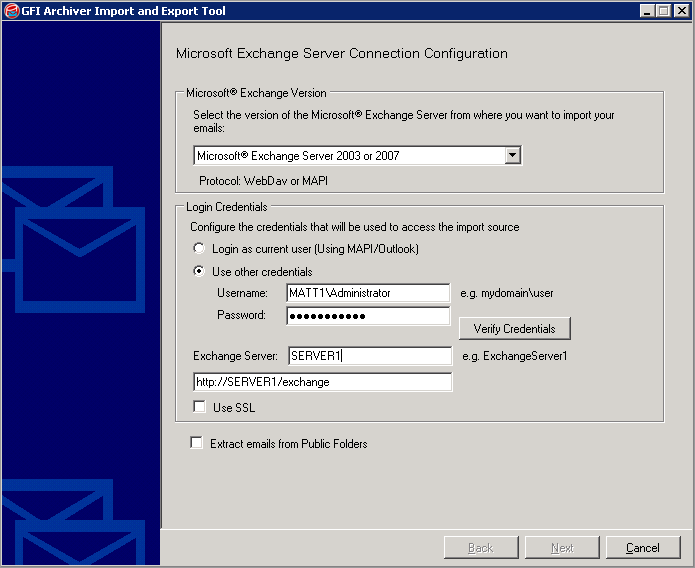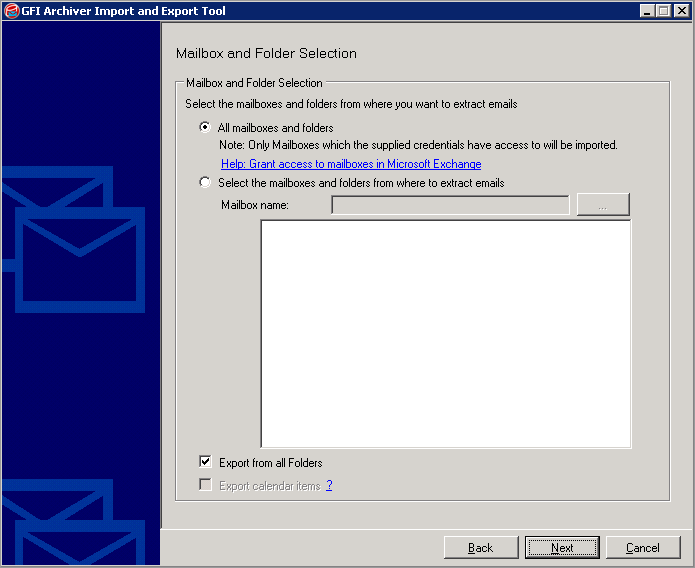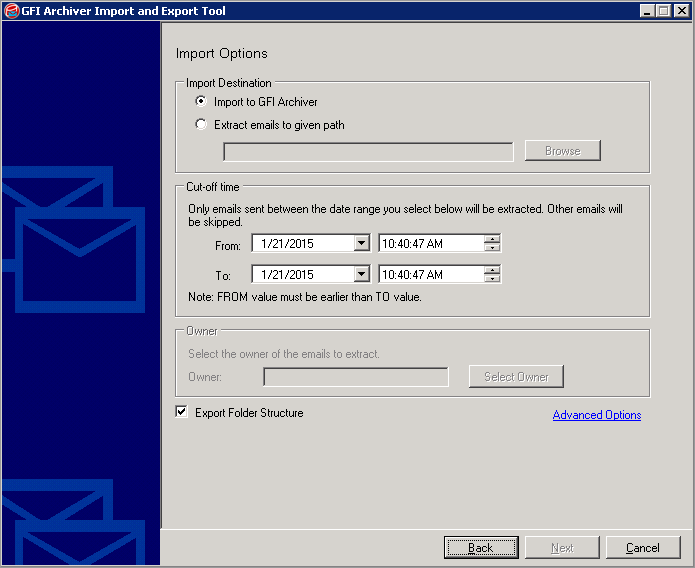Import Emails From Microsoft® Exchange Mailboxes
The Import Export Tool enables you to extract emails from Microsoft® Exchange mailboxes and import them to the GFI Archiver Archive StoresA collection of email sources, email metadata and search indexes within GFI Archiver.
The import feature in the Import Export Tool is useful to migrate emails that are already in the mail system when GFI Archiver is installed, or that failed to be archived using another method.

The process of adding email from Microsoft® Exchange Mailboxes to GFI Archiver involves the following procedure:
- The Import Export Tool extracts emails from Microsoft® Exchange mailboxes.
- The Import Export Tool converts the emails to MIMEMultipurpose Internet Mail Extensions format.
- The Import Service processes the extracted emails based on the date of each email.
- GFI Archiver stores emails in the appropriate archive store.
Using the Import Export Tool is a two step process:
IMPORTANT
This section only applies when extracting items from a mailbox on a remote machine. If importing emails from the same machine where GFI Archiver is installed, skip this step.
GFI Archiver lets you extract email mailboxes located on remote machines:
- From the GFI Archiver machine, navigate to <GFI Archiver installation path>\MAISGFI Archiver Import Service\
- Share Pickup folder to give full read and write permissions to the remote machine from where the Import Export Tool is to run. To share a folder:
- Right-click Pickup folder and select Share…
- Specify the credentials under which the Import Export Tool will run and click Add.
- From the Permission Level drop-down list next to the added user, select Co-owner.
- Select Share and click Done.
- Right-click Pickup folder and select Share with > Advanced sharing
- In the Sharing tab, click Advanced Sharing.
- Check the Share this folder checkbox.
- Click Permissions tab and specify the user credentials under which the Import Export Tool will run. Ensure Full Control is selected for the added user and click OK.
- Return to where GFI Archiver is installed and copy the
MarcImportExportfolder. - Paste the folder
MarcImportExporton remote machine. - Open command prompt with elevated privileges.
- Browse to the
MarcImportExportfolder on the local machine. - Run the following command:
regsvr32 redemption.dll - Run MArcImportExport.exe.
To export emails from Microsoft® Exchange mailboxes and import them into GFI Archiver:
- Launch the Import Export Tool by navigating to Start > Programs > GFI Archiver > GFI Archiver Import Export Tool.
- Click Import from Microsoft Exchange mailbox.

Importing from a Microsoft Exchange mailbox
- From the Microsoft® Exchange Version area, select the applicable option based on the Microsoft Exchange version available and the protocol to be used:
| Option | Description |
|---|---|
| Microsoft® Exchange Server 2003 or 2007 |
Select this option to use WebDAV or MAPIMessage Application Programming Interface with Microsoft Exchange Server 2007 or earlier. |
| Microsoft® Exchange Server 2007 or 2010 or 2013 or 2016 |
Select this option to use EWS with any version of Microsoft Exchange. |
| Microsoft® Exchange Server 2013 or 2016 (MAPI/Outlook) | Select this option to use MAPI 2013 with Microsoft Exchange 2013 or 2016. |
| Microsoft® Exchange Online (Exchange/Office365) | Select this option if you have Microsoft Exchange Online or Microsoft 365. |
- From the Login Credentials area, configure a user with permissions to access the Microsoft® Exchange mailboxes to import. Configure:
| Option | Description |
|---|---|
| Login as current user |
Login to Microsoft® Exchange Server using the credentials of the logged on user. |
| Use other credentials |
Specify the username (use |
| Exchange Server | Specify the Microsoft® Exchange Server name or IP address. |
| Use SSL | Check this option if the Microsoft® Exchange Server requires SSL connection. |
| Extract emails from Public Folders | Check this option to extract emails from public folders. |
| Verify Credentials | Click this button to confirm access and authentication with Microsoft® Exchange Server. |
- Click Next to continue.

Import from Microsoft Exchange: MailboxA directory or folder used for receipt, filing, and storing messages of emails. and folder selection
- Select the mailboxes and folders to import:
| Option | Description |
|---|---|
| All mailboxes and folders | Import all the emails in mailboxes that the configured user has access to. |
| Select the mailboxes and folders from where to extract emails |
Select this option to import the emails of a particular mailbox. Specify the Mailbox name or click the |
| Export from all Folders | Check this option to extract emails from public folders. |
| Export calendar items |
Check this option to extract historical calendar items from public folders. NOTE The Import Export Tool is recommended only when importing historical calendar items. For current calendar items, we suggest using the Archive Assistant. For more information refer to Importing Emails and Calendar Items via the GFI Archiver Archive Assistant. IMPORTANT To export Calendar Items you must use the Login as current user (Using MAPI/Outlook) option. |
- Click Next to continue.

Import from Microsoft Exchange: Configure import options
- From Import destination area, select one of the following options:
- Import to GFI Archiver – import emails to GFI Archiver Archive Stores.
- Extract emails to given path – extract emails to a location on disk in .txt format
- In the Cut-off time area, specify a date range. Emails sent between the specified dates are extracted, while other emails are ignored.
- In the Owner area, enable Select the owner of the emails to extract and specify the user in the Owner text box. For example, if user@testdomain.com is specified in the Owner field, imported emails are displayed under user@testdomain.com.
- (Optional) Click Advanced Options and select from the following options:
| Option | Description |
|---|---|
| Ignore already processed flag | If checked, the process goes through all emails in the selected date range, irrelevant of whether an export process had already occurred before and exported the same emails. If unchecked, the process skips already exported emails in the selected date range and resumes with the unprocessed ones. |
| Do not mark processed emails | Select this option if you want Import Export Tool to process emails without marking them as processed. The result is that there will be no flag to ignore when emails are processed again. |
| Clear email flag prior processing | If in a previous export email have already been marked, the flag indicating this process is removed. |
- Click Next to start the export process.
- When the process completes, click Finish.
NOTE
The duration of the process depends on the amount of emails to extract.
